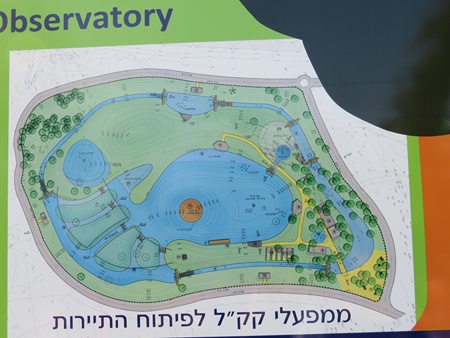Aerial map of Rosh Tzippor, which looks like a bird's head. Photo: Yoav Devir
On December 18th, a ceremony was held to celebrate the laying of the foundation stone for the new Rosh Tzippor bird-watching center to be established in the forest with the support of the Besen Family Foundation and Friends of JNF Australia. Among those present were KKL-JNF officials, the Mayor of Tel Aviv, the Australian Ambassador to Israel and relatives of the donors.
"Residents of central Israel deserve to have a green area that will be accessible to everyone. The bird-watching center will add another natural gem to Yarkon Park," said KKL-JNF World Chairman Efi Stenzler at the ceremony. In his speech he recalled the task that JNF Australia had taken upon themselves in the wake of the Maccabiah disaster: to work for the rehabilitation of the Yarkon River. "In those most difficult times the community displayed exceptional generosity of spirit," said the world chairman.
KKL-JNF began to plant the Rosh Tzippor (Hebrew for bird's head) Forest in the 1950s, and work still continues there today. The first trees to be planted were eucalypti, themselves natives of Australia. In recent years, however, local varieties such as Tabor oak, Judas trees and two species of mastic tree have been added to the mix.
Aerial map of Rosh Tzippor, which looks like a bird's head. Photo: Yoav Devir
The forest has dense undergrowth and it is home to a variety of songbirds and waterfowl. These, however, are not the source of its name, which derives instead from the shape of the forest: when viewed from the air it has the appearance of a bird's head with an eye in the appropriate spot.
Tel Aviv Mayor Ron Huldai, a former pilot and commander in the Israeli Air Force, is probably long familiar with the landscape of the park as seen from above. In his present capacity as mayor, he is well aware of the park's special importance to the residents of his city. "This park is a miracle, a green oasis surrounded by fast highways and urban development," he told those present at the ceremony.
The mayor added that the site is one of the most frequently visited in the country. And, indeed, on a weekday morning the park is thronged with people: cyclists, joggers, groups of schoolchildren, courting couples and parents with baby buggies.
The park is crisscrossed by a number of walking routes, cycle paths and jogging trails. The easier footpaths are suitable for family outings and accessible to people with disabilities; children will enjoy the zip lines, rope bridges, roundabouts, seesaws and wooden climbing equipment in the adventure playground.
Other places to visit in Rosh Tzippor Forest include the historic Seven Mills (Sheva Tahanot) site, where water mills constructed along the banks of the Yarkon River in the 19th century remained in use until around a hundred years ago. On Napoleon Hill the remains of settlements dating back thousands of years can be seen.
Right: Eva & Marc Besen, Efi Stenzler, and H.E. Dave Sharma sign the document to be placed in the cornerstone. Photo: KKL-JNF Photo Archive.
Left: Birds on the Yarkon River. Photo: Yoav Devir
Australian Ambassador to Israel Dave Sharma said that on his travels around the country he had been greatly impressed by everything Israel has managed to achieve in such a short time against all the odds. "Thanks to the active Zionist Jewish community of Australia and its collaboration with KKL-JNF, we have had the privilege of taking part in the building of the State," he added.
The main contribution towards the establishment of the bird-watching center was donated by the Besen Family Foundation of Melbourne, and over thirty members of the family took part in the ceremony. Foremost among them were Marc Besen, who celebrated his 90th birthday in the course of the visit, and his wife Eva.
"Our family has grown since our last visit to Israel, and the State, too, has grown and developed," said Mr. Besen. "We are very happy to be here playing a modest role in making the region green and contributing in a small way towards the growth of the State of Israel as a whole."
Australian donors Geoffrey and Velmae Morris of Perth were likewise present at the ceremony. "I learned from my father that Israel is our native land and our second home, and everything we can do for the State brings us great happiness," said Geoffrey Morris. "I regard the rehabilitation of the Yarkon River as a particularly important project, and, of course, developing nature tourism in Israel is vital, too."
The list of Australian donors who contributed to the establishment of the bird-watching center includes the Ferster and Schaffer families, the estate of Stephen and Rita Gerstl, Sussanne Pinkus and Esta Blashid; an additional donation was made by the Beer-Gabel family of France.
After the speeches were over, all those present made their way to the spot where the foundation stone would be laid. Before the hole was covered up with cement, the participants filled it with documents bearing their signatures in order to mark the establishment of this new site.
Architect Gidon Sarig presented the plans for the bird-watching center, Dr. David Pergament, Director of the Yarkon River Authority, told those present about the park and the rehabilitation of the waterway, and the day's activities concluded with a tour of Yarkon Park in a vehicle resembling a motorized train. Like the residents of Tel Aviv and its surrounds and visitors from all over the country, the Australian guests enjoyed the lake, the tropical garden, the rock garden, the park landscapes and the riverbank scenes.










